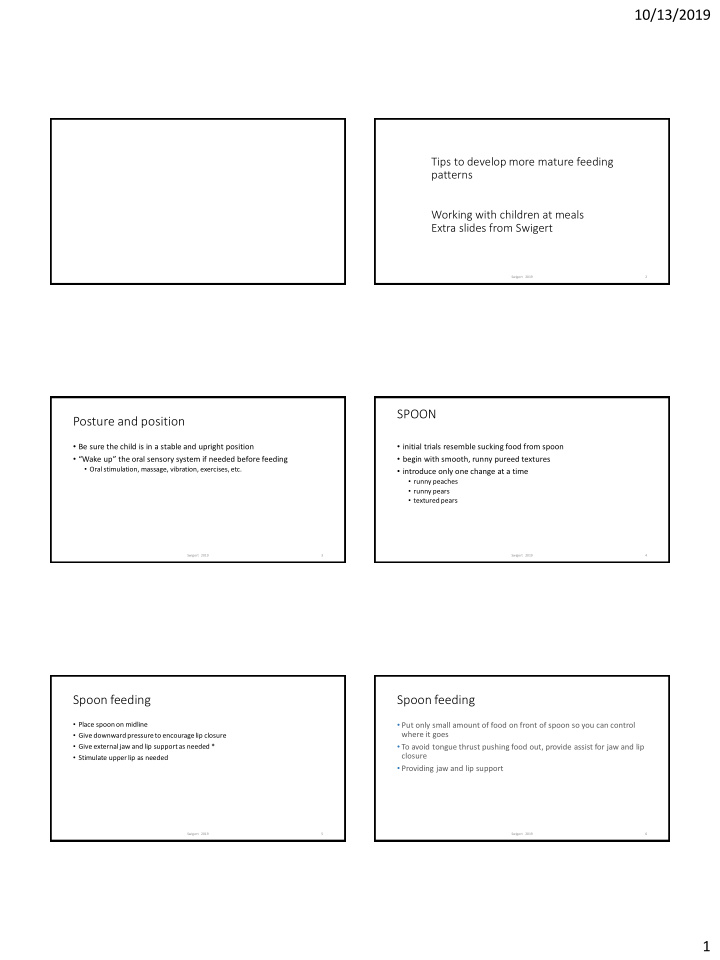



10/13/2019 Tips to develop more mature feeding patterns Working with children at meals Extra slides from Swigert Swigert 2019 2 SPOON Posture and position • Be sure the child is in a stable and upright position • initial trials resemble sucking food from spoon • “Wake up” the oral sensory system if needed before feeding • begin with smooth, runny pureed textures • Oral stimulation, massage, vibration, exercises, etc. • introduce only one change at a time • runny peaches • runny pears • textured pears Swigert 2019 3 Swigert 2019 4 Spoon feeding Spoon feeding • Put only small amount of food on front of spoon so you can control • Place spoon on midline where it goes • Give downward pressure to encourage lip closure • Give external jaw and lip support as needed * • To avoid tongue thrust pushing food out, provide assist for jaw and lip • Stimulate upper lip as needed closure • Providing jaw and lip support Swigert 2019 5 Swigert 2019 6 1
10/13/2019 Spoon feeding cup • Foods of mixed consistencies may be very difficult • Careful positioning of head • Place cup on the child ’ s lower lip, not the teeth or gums • cereal with milk • Provide jaw support • fruit cocktail • Tilt only far enough to let liquid touch upper lip • green beans • peas • stewed tomatoes Swigert 2019 7 Swigert 2019 Spoon ‘drinking’ Cup drinking • Spoon turned sideways • Coordinated jaw stabilization may not be seen until 2 years of age • Spoon on edge of lips • Flow of liquid into the mouth may startle the child • try thicker liquids • Liquid just to the lips • for older children, use age appropriate thick drinks like fruit smoothies Swigert 2019 9 Swigert 2019 10 CHEWING - solids Chewing solids • If child is not safe to eat solids, can begin to introduce things to chew • Place food on lateral chewing surfaces * • Use foods that are easily softened with saliva (e.g. cookie, cracker) in a mesh holder • Avoid foods that fall apart (e.g. pretzels) or don ’ t dissolve well (e.g. bread) • Alternate sides for presenting Swigert 2019 11 Swigert 2019 12 2
10/13/2019 Chewing - tongue lateralization Simulated chewing • Try foods with long, thin shape the feeder can hold • Can use therapy tools to practice chewing – French fries, cheese, potato • Place pieces at midline of tongue for child to move laterally to chewing surfaces Swigert 2019 13 Swigert 2019 14 Biting Straw drinking • Don ’ t introduce until child can move food from midline to lateral chewing surface • Great variability in typically developing children • You can assist moving it to the side • 1 - 3 years of age • Simulate by pulling slightly on food placed between lateral chewing surfaces, or scraping on • Don ’ t introduce until coordinated with cup drinking top teeth Swigert 2019 15 Swigert 2019 16 Straw drinking Straw drinking • Working to achieve saliva control, lip rounding, and tongue retraction • Precursor to straw drinking • Try to avoid having the child rest the straw on the • Use bottle that when squeezed, liquid will move up straw tongue • Fill bottle with liquid consistency that child is capable of handling • As the child is learning to pull the liquid up through the straw with the • It should be between the lips lips, the therapist can gently assist by squeezing the bottle Swigert 2019 17 Swigert 2019 18 3
10/13/2019 Dipping the straw Moving to harder straws • For children who can’t pull the liquid up in the straw at all, try dipping • Once child has mastered the squeeze bottle, move to a short and straw in liquid and slowly releasing into mouth at midline wide straw • Moves from shorter, wider straws to long complex straws Swigert 2019 19 Swigert 2019 20 4
Recommend
More recommend